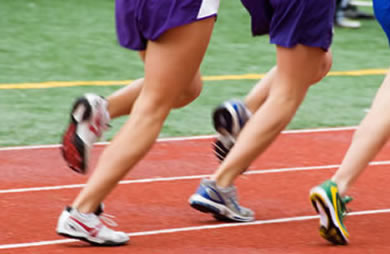By CD318156,
SparkPeople Blogger
11/27/2010
The old running adage is as follows, “in order to run, one must run”—this is commonly referred to as the Principle of Specificity of Training. In other words, in order for you to become a more efficient runner, you must spend time running. But doing too much of the same activity day in and day out, regardless of the activity that you do, may lead to overuse injuries, burnout and a decrease in your running performance. This is where cross-training can be a huge benefit for runners. Cross-training allows a runner a break from the repetitive strain of running while allowing you to continue to build an aerobic base, develop stronger muscles, enhance muscle recovery, improve muscle balance, while adding variety to your running routine.
For an injured runner, cross training workouts allow you to continue building an aerobic base and maintain or build muscle strength while recovering from your injury. However, it is important that you ask your physician what exercises you have been cleared to do so that you do not do further damage and delay your return to running.
Cross-training activities should not be a replacement for a scheduled run, however from time to time doing a cross-training activity in place of an easy run may actually enhance your running. Just be certain you still take a full day off each week for complete rest, preferably before your long run day so that you receive the greatest benefit of your long runs.
There are two approaches to cross-training for runners--those activities that enhance running and those activities that complement running. Depending on your training and health situation, this will help determine the type of cross-training activities you will want to consider adding to your workout routine. Remember cross-training is a way to keep your exercise routine fresh, lessen your risk for injury, and help develop muscle balance, therefore allowing you to become life-long runner.
Cross-Training Activities that Complement Running
Activities that complement your running are those that work the muscles in a different manner than running, as well as engaging muscles that you may never use while running. Performing these types of activities will allow you to build greater muscle strength and balance, therefore reducing your risk for injury.
- Swimming
Swimming can be a beneficial cross-training activity for runners, especially for those recovering from an injury. Because swimming is a non-weight-bearing activity, it gives the joints and connective tissues a break from the impact of running while allowing you to maintain some form of aerobic fitness. By targeting all the major muscle groups (quadriceps, hamstrings, glutes, abs, lower back and upper body) swimming allows your legs a break while developing upper body musculature.
- Cycling
Cycling, whether indoors or outdoors, allows for development of the quadriceps and shin muscles which are slower to develop in runners. It also helps develop and strengthen the connective tissue of the knees, hips and ankles which may reduce your risk for injury. However, some experts recommend that if you are going to use cycling as a cross-training activity, you should not cycle on your rest day or non-run days as this activity is far too taxing on the muscles which may make running difficult. So what do you do? Run first and then do your cycling later in the day or after your run.
- Indoor Rowing
Although the indoor rowing machine is not quite as popular as the elliptical and treadmill, it can be a great cross-training activity for runners looking to develop their quadriceps and hips while increasing upper body strength. Good form is necessary when using the rower so that your legs muscles do the primary work and not your back which can lead to straining of the back muscles.
- Stair Climbing
Whether you elect to climb stairs in your office building or at the gym on the Stairmaster Mill, stair climbing provides an excellent quadriceps workout for runners. Because runners tend to have stronger hamstrings, performing a cross training activity that develops the weaker quadriceps allows for greater muscle balance, therefore reducing the injury risk that comes from muscle imbalances.
- Plyometrics
If you are unfamiliar with the term plyometrics, these are basically high intensity, explosive exercises such as jumping, bounding and hopping drills, with box jumping ranking as one of the most popular plyometric activities. While these activities are an excellent source for developing a runner's strength, speed, range of motion, push-offs and stride length, it is important to note that these activities should only be performed by highly conditioned athletes. Using proper form is essential when doing these types of drills. Because of their explosive nature, landing improperly can lead to a greater incidence of injury. If you are not familiar with doing these type of activities, you may want to work with a Certified Personal Trainer for a few sessions until you have mastered the techniques.
- Walking
Many runners are surprised to hear that walking is actually a great cross training activity. The reason, walking allows you to develop the muscles and connective tissues in a different manner from running without the high impact. And because it can be done almost anywhere at any time, doing a vigorous walk after an intense run makes a nice active recovery. If you choose to use walking as a cross training activity on your non-running days, walk at a brisk enough pace to get the cardio-respiratory benefits. Remember too, the greater the arm pump, the more calories you burn and the faster you will walk.
Cross-training Activities that Enhance Running
These activities are those that utilize the muscles, connective tissues and joints in a similar manner used in running without the impact. Many runners will use these workouts when recovering from an injury or when going through rehab.
- Deep Water Running
Deep water running, also known as pool running, is exactly as the name implies, running in deep water. This is achieved by slipping on a flotation device, such as an AquaJogger, so that your legs are suspended off the bottom of the pool. This activity most mimics running on land without the impact on the joints, muscles and connective tissues. It makes a great cross-training activity for injured runners, however, many healthy runners may find it quite boring. One of the disadvantages to this activity is the need to have access to an indoor pool during the colder months and/or a pool deep enough to perform this workout.
- Elliptical Trainer
The elliptical trainer is one of the most popular cardio machines in the gym and because it mimics running action without the impact, it makes an excellent cross-training activity. Even though the elliptical is a weight-bearing activity, it does not elicit the same impact to the joints that running does. The elliptical also helps develop a runner's core and leg muscles and if you use one with the arm levers, the pushing and pulling motion allows you to develop a stronger arm swing therefore helping make you a more efficient runner.
- Cross-Country Skiing
While many of us may not have access to snow to participate in this cross-training activity, using an indoor cross country ski machine, such as a Nordic Track, has been shown to give similar benefits in developing better running economy--the amount of oxygen a runner utilizes during a run. Because the hips, quadriceps, core and upper body are all utilized in performing this workout, it allows for development of the weaker quadriceps without the impact. And one of the greatest benefits is the high calorie expenditure that comes from doing this activity. If you are looking for an activity to burn calories that even exceed running, the cross-country ski machine may be a great addition to your workout routine.
Please remember that cross-training activities are not a replacement for your scheduled day off. Rest is just as vital to your training as running, for it is during your rest period that your body begins the adaptation process to making you a more efficient runner.
Running too much can lead to a greater incidence of injury and actually slow your progress and running performance. This is why cross-training plays such an important role in keeping us active and injury-free. Cross-training activities are meant to complement and enhance your running by giving your muscles a break from running while still allowing you to burn calories and develop greater aerobic fitness. And by adding variety to your workout routine you may find yourself looking forward to your runs and allowing you to become a life-long runner.
References:
Burfoot, Amby. 2004. Runner's World Complete Book of Running. Rodale.
Fitzgerald, Matt. 2004. Runner's World Guide to Cross Training. Rodale.
Galloway, Jeff. 2002. Galloway's Book on Running. California: Shelter Publications.
Glover, Bob, Jack Shepard and Shelly-lynn Florence Glover. 1996. The Runner's Handbook. New York: Penguin Books.
Sparks, Ken. 1996. The Runners Book of Training Secrets. Pennsylvania: Rodale.
Stanton, John. 2010. Running The Complete Guide to Building Your Running Program. Ontario: Penguin Books.
Do you cross train? What type of cross training activities do you do?
|
|























